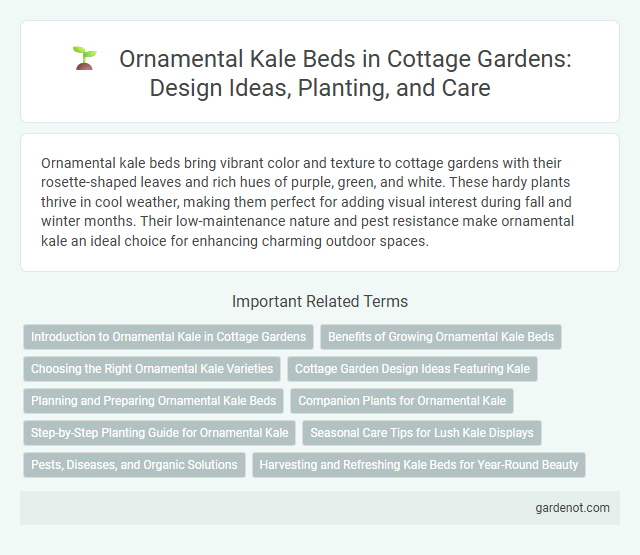Ornamental kale beds bring vibrant color and texture to cottage gardens with their rosette-shaped leaves and rich hues of purple, green, and white. These hardy plants thrive in cool weather, making them perfect for adding visual interest during fall and winter months. Their low-maintenance nature and pest resistance make ornamental kale an ideal choice for enhancing charming outdoor spaces.
Introduction to Ornamental Kale in Cottage Gardens
Ornamental kale thrives in cottage gardens, offering vibrant hues and textured foliage that enhance garden aesthetics. Its hardy nature allows it to withstand cooler temperatures, extending seasonal interest from late fall through early spring. This versatile plant pairs well with flowering perennials and herbs, creating a charming, layered garden bed.
Benefits of Growing Ornamental Kale Beds
Ornamental kale beds enhance cottage gardens by offering vibrant, textured foliage that thrives in cooler seasons, extending garden interest into autumn and winter. These plants improve biodiversity by attracting beneficial insects such as pollinators and natural predators for pests, promoting a healthier garden ecosystem. Their low-maintenance growth and tolerance to frost make them an ideal choice for sustainable and visually appealing garden design.
Choosing the Right Ornamental Kale Varieties
Selecting the right ornamental kale varieties involves considering factors like leaf color, texture, and hardiness to achieve a vibrant cottage garden bed. Varieties such as 'Nagoya Red' and 'Osaka Purple' offer rich hues and ruffled leaves that enhance visual interest throughout fall and winter. Choosing cultivars with strong cold tolerance ensures longevity and consistent ornamental appeal in cooler climates.
Cottage Garden Design Ideas Featuring Kale
Ornamental kale beds bring vibrant purples, greens, and white hues to cottage garden design ideas, creating textured focal points with their ruffled leaves. Combining ornamental kale with flowering perennials like lavender, foxgloves, and daisies enhances seasonal interest while supporting pollinators. This hardy, low-maintenance plant thrives in cool weather, making it ideal for extending cottage garden color into late fall and early winter.
Planning and Preparing Ornamental Kale Beds
Planning an ornamental kale bed requires selecting a site with full sun and well-drained, fertile soil enriched with organic matter to promote vibrant leaf coloration. Preparing the bed involves loosening the soil to a depth of at least 12 inches and incorporating balanced fertilizer with a ratio such as 10-10-10 to support healthy growth. Proper spacing of 12 to 18 inches between kale plants ensures adequate airflow, reducing the risk of disease and encouraging lush, decorative foliage.
Companion Plants for Ornamental Kale
Companion plants for ornamental kale enhance both visual appeal and garden health by providing contrasting textures and colors, such as pansies, violas, and ornamental cabbages. These plants thrive in similar cool conditions, promoting robust growth and deterring pests naturally. Incorporating dusty miller and snapdragons alongside ornamental kale creates a vibrant, dynamic garden bed that supports biodiversity and extends the growing season.
Step-by-Step Planting Guide for Ornamental Kale
Plant ornamental kale in well-drained soil enriched with organic compost, spacing plants 12 to 18 inches apart to allow full foliage development. Start seeds indoors 8-10 weeks before the last frost or sow directly in garden beds once temperatures drop to 45degF (7degC). Maintain consistent moisture and full sun exposure to enhance vibrant leaf coloration and prevent bolting.
Seasonal Care Tips for Lush Kale Displays
Ornamental kale beds thrive with regular watering to maintain moist, well-drained soil, especially during warm seasons. Applying a balanced, slow-release fertilizer every 4 to 6 weeks promotes vibrant leaf color and robust growth. Mulching around the plants helps retain moisture, suppress weeds, and protect kale from temperature fluctuations, ensuring lush and healthy displays throughout the growing season.
Pests, Diseases, and Organic Solutions
Ornamental kale beds in cottage gardens can be prone to pests like aphids, cabbage worms, and slugs that cause leaf damage. Common diseases include downy mildew and black rot, which thrive in moist conditions and hinder plant growth. Organic solutions such as neem oil sprays, introducing beneficial insects like ladybugs, and maintaining proper air circulation help control infestations and keep ornamental kale healthy.
Harvesting and Refreshing Kale Beds for Year-Round Beauty
Harvest ornamental kale in late fall when the leaves are vibrant and fully developed, cutting leaves at the base to encourage fresh growth. Remove any yellow or damaged foliage regularly to maintain a tidy appearance and prevent disease. Refresh kale beds in early spring by trimming old growth and applying balanced organic fertilizer to promote continuous, lush foliage for year-round garden appeal.
Ornamental kale bed Infographic

 gardenot.com
gardenot.com